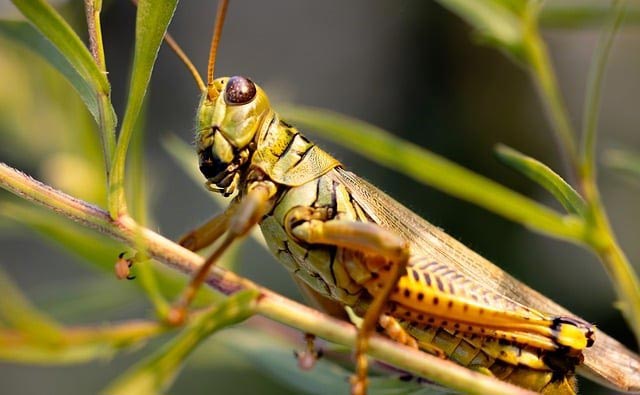
Image by Ted Erski from Pixabay
August 7, 2024 - By Daniel Munch - In U.S. history, narratives of vast swarms of locusts ravaging farmland are often  recounted. Not all grasshoppers are locusts, and the swarms aren’t quite as big as they were in the 1800s, but grasshoppers and Mormon crickets remain a persistent risk to agriculture, inflicting significant damage to rangeland and crops.
recounted. Not all grasshoppers are locusts, and the swarms aren’t quite as big as they were in the 1800s, but grasshoppers and Mormon crickets remain a persistent risk to agriculture, inflicting significant damage to rangeland and crops.
Almost 400 native species of grasshoppers inhabit the Western U.S., though only a small fraction—about 12 species—are considered pests. Grasshoppers compete with cattle and other herbivores for forage and are more likely to become a threat in areas with less than 30 inches of rainfall annually. They can consume up to 50% of their body weight each day in forage—with just 30 pounds of grasshoppers devouring as much as a 600-pound steer in a day.
Grasshoppers are an even bigger menace to crop farmers and ranchers on public and private lands when drought conditions are added to the mix. Grasshopper and cricket outbreaks not only result in the physical destruction of forage and crops but also contribute to soil erosion and degradation, disrupt rangeland nutrient cycles and impede rangeland water filtration, which can have lasting impacts on rangeland ecosystems.
Western landowners face heightened risks from grasshoppers due to the substantial amount of federally owned land in the region. Pest infestations on federal lands reduce the quantity and quality of forage available for those with public lands grazing leases. In the absence of grasshopper and cricket management on federal lands, insects can migrate onto private lands, undermining the effectiveness of common private pest management efforts.
In Northern California’s Modoc County alone, the agricultural commissioner estimated more than $52 million in crop and rangeland losses due to severe grasshopper infestations in 2023. This included $16 million in damage to alfalfa, which had a yield decrease from 6.4 tons per acre to 4.48 tons per acre. Other Modoc County impacts included $15 million in grain hay yield losses, $6 million in lost pasture forage value, $2 million in small grain yield losses and $1.8 million in other hay yield losses.
In neighboring Siskiyou County, conservative estimates of crop and forage yield losses exceeded $32 million. In Plumas County, they were more than $1 million.
Alfalfa has been particularly impacted. Conservative estimates put production value losses in 2023 due to grasshopper infestations at $318 million in western states. This represents a baseline number with true impacts likely hundreds of millions of dollars higher. Losses of this magnitude are detrimental to operations already operating on small and often negative margins and reveal the true threat of these insects on farmers’ and ranchers’ livelihoods.
Another way to pinpoint some grasshopper damages is through federal Risk Management Agency indemnity data that show payments made on crop insurance policies triggered from an insect-related cause of loss. In Montana, for instance, there were $7.7 million in indemnity payments made for crops lost to insects in 2023. This includes more than $5 million in wheat, more than $1.6 million in dry peas and $439,725 in barley.
The Rangeland Grasshopper and Mormon Cricket Suppression Program, administered by the U.S. Department of Agriculture Animal Plant Health Inspection Service, covers 100% of the treatment costs on federal and tribal rangelands. It pays 50% of costs on state lands, with the state picking up the rest, and 33% on private rangeland, with state and landowners sharing remaining costs.
It’s important to note that APHIS is unable to conduct suppression programs for grasshoppers and Mormon crickets on private croplands. However, they do perform rangeland suppression treatments in areas where federally managed rangeland is directly adjacent to private croplands.
APHIS may apply insecticides using several different methods, including using ground equipment by distributing baits usually made out of wheat bran or rolled oats and carbaryl or aerially by spraying ultra-low-volume applications on treated acres. Most commonly, APHIS uses a method of integrated pest management for grasshoppers and crickets called reduced area and agent treatments to limit costs and insecticide use.
Between 2019 and 2023, APHIS protected over 3.33 million acres across eight Western states, with 2.8 million acres treated for grasshopper control and 482,000 acres for Mormon crickets. This has corresponded to $5.68 million in program treatment expenditures during the five-year span.
Even in the 21st century, outbreaks of grasshoppers and Mormon crickets pose a threat to Western U.S. agriculture. Efforts to manage and mitigate grasshopper populations involve sophisticated monitoring and targeted treatments. Continued coordination and efforts among the federal government, states and private landowners is essential to safeguarding the livelihoods of farmers and ranchers against these small but hungry pests.
(Daniel Munch is an economist for the American Farm Bureau Federation. This article is adapted from his report, “Grasshoppers Eating into Western Farmers’ and Ranchers’ Bottom Lines,” which may be found at fb.org/market-intel.)
The California Farm Bureau Federation works to protect family farms and ranches on behalf of nearly 32,000 members statewide and as part of a nationwide network of more than 5.5 million Farm Bureau members.
Source: Reprinted with permission CFBF








